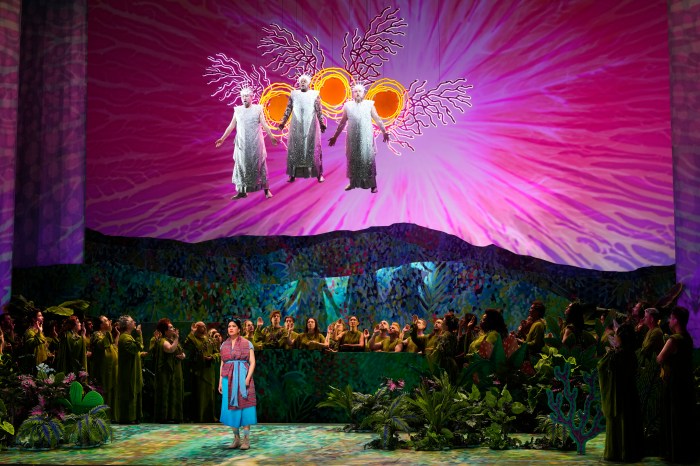Andrew Rossi has developed a reputation for pulling back the layers of New York City institutions. Best known for his Emmy award-nominated documentary “Page One: Inside The New York Times” (2011), the filmmaker is also behind HBO’s “Le Cirque: A Table In Heaven” (2007), about the reopening of the famed French restaurant in midtown.
His latest film, “First Monday In May,” takes viewers behind the scenes of the Metropolitan Museum of Art, detailing the preparations its annual fashion exhibition (last year’s “China: Through the Looking Glass” is the focus here) and the related star-studded gala headed by Vogue’s Anna Wintour, for whom the museum’s costume center is named.
amNewYork spoke with the director ahead of the film’s premiere, chosen to officially open the Tribeca Film Festival.
How did you get involved with the film?
I was approached in the spring of 2014 about making this film. I met with Anna Wintour. I was instantly really interested in the idea of being able to go behind the scenes at the Metropolitan Museum of Art. Every movie I’ve made has … or, most of the films I’ve made, sort of go behind the scenes of a great institution to understand, through the journey of an individual, why that institution is so highly regarded in our society.
I think Andrew Bolton, [the curator of the exhibit], is the perfect vehicle to look at how museums are repository for great artwork, but also for the study of creative imagination. The whole premise of this exhibition that we followed, “China: Through the Looking Glass,” is really a testament to how designers can, [in a] postmodern way, take many different ideas and put them together in something that is usually functional. It can be worn, but evokes so many sort of tropes about mystery, danger, romance.
I was just thrilled to be able to go behind the scenes at the Metropolitan Museum, but similarly, I was interested in going through, or behind the scenes of, or unpacking, the mythology around Anna Wintour. Being able to see her here, I think, driven by something that she is very personally invested in, which is the life of the museum, the future of the costume institute, the Anna Wintour Costume Center, and seeing her relationship with Andrew Bolton, which is one of being an advocate and being so supportive, is really new, I think, in terms of the other depictions of her that we have in the popular culture, whether it’s “The Devil Wears Prada” or other kind of means about her.
What did you learn from observing how people interact with Wintour?
I think you see Sylvana Ward Durrett, who is the director of special events at Vogue, and who is, year round, working to prepare the next year’s Met Gala. The relationship that she has with Anna is very collegial … it’s very healthy, in the most clinical look at employer-employee kind of dynamics. It’s not in any way tyrannical, or capricious. Anna does not seem to be, in any way, capriciously leading her group of employees or people who are instrumental to the creation of the gala. I think that gets a key point that Baz Luhrmann raises [in the film], which is Anna is a tough boss in the sense that she has high standards, and she’s not afraid to make sure that they are accomplished, but there’s nothing sort of capricious about it. Those qualities in the profile of a male CEO or other executive are usually celebrated, rather than made the fodder of jokes. I think you see that in the way that she treats the people she works with.
What’s your favorite moment in the movie?
Well, I do love the moment that Rihanna arrives on the red carpet, it’s definitely one of my favorites because I think it brings to life this notion that [curator] Harold Koda explains in the beginning of the film, which is that Anna Wintour sort of understood that celebrity and couture together, the sum of their parts, is bigger than each of them individually. Rihanna, when she’s wearing that Guo Pei dress and the train is cascading down the red carpet, she embodies the queen of the night idea that Andre Leon Talley describes. She transcends in that moment and she is like a work of art herself.
The other moment I really like a lot is when Andrew Bolton is in tails and he’s walking through the exhibition by himself. It’s finally done. The first few people have come in, and a song plays. “Wild is the Wind” … It’s a rendition by Cat Power. I love it because there’s a line in there that says, “We are creatures, like the wind, wild is the wind.” You’re literally seeing the feathers from, I think it’s a Galliano dress, like, blowing in the wind while the song is playing. Through Andrew Bolton’s eyes, we see the clothes, and they take on almost anthropomorphic life. They’re like creatures. It is in service of the bigger idea in the film that fashion is art and that these works of art are more than just clothing, they’re like creatures practically.
What does it mean to you to be opening Tribeca?
It is a great honor to be able to premiere the film at Tribeca because the festival was founded in the hope of nurturing and supporting the arts in New York City. The work that Andrew Bolton does and the position that the Metropolitan Museum occupies in this city is so tremendous for it’s cultural life, and certainly it’s uptown and it’s a very different kind of world than, let’s say, independent film. Nonetheless, it’s a great pillar of arts in the city. Even the work that Vogue does, too. Vogue, now located in the World Trade Center, or in One World Trade, just steps away from the World Trade Center, it’s a great testament to New Yorkers rising from that event of 9/11, which inspired the creation of Tribeca. I hope it helps to recall why we care about the creative and cultural life of this city.

















